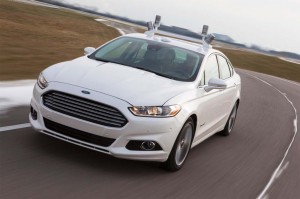Ford is teaming up with the Massachusetts Institute of Technology and Stanford University in an effort to solve some of the vexing technical challenges involved in autonomous driving.
The MIT research will focus on scenario planning, one of the building blocks for the artificial intelligence required so automated vehicles can predict the actions of other vehicles and pedestrians – a challenge for even the most experienced human drivers.
Meanwhile, the team at Stanford will explore how to give onboard sensors the ability to look around obstructions.
“To deliver on our vision for the future of mobility, we need to work with many new partners across the public and private sectors, and we need to start today,” said Paul Mascarenas, chief technical officer and Vice President, Ford research and innovation.
“Working with university partners like MIT and Stanford enables us to address some of the longer-term challenges surrounding automated driving while exploring more near-term solutions for delivering an even safer and more efficient driving experience,” Mascarenas added.
A number of carmakers, notably Nissan, Daimler and General Motors, are exploring automated driving as the technology required to put it on the road matures rapidly. Nissan announced last year plans to put its first “fully autonomous” vehicle into production by 2020. But several manufacturers already sell vehicles with semi-autonomous features that assist can detect obstacles in the road, maintain the pace of traffic and even bring a vehicle to a complete stop in an emergency.
(Study says autonomous vehicles could account for 1/3 of US sales by 2035. Click Here for more.)
Ford CEO Alan Mulally earlier this month declared that he wants Ford to be considered a technology leader in all facets of mobility, including autonomous driving. Ford’s program is based in Dearborn, rather than Silicon Valley, where several other self-driving vehicle programs have been located.
Last month, Ford unveiled an automated Fusion Hybrid research vehicle that uses some of the technologies already in its production vehicles – but it has added four LiDAR sensors that allow the vehicle to generate a real-time 3D map of the surrounding environment.
While the vehicle can sense objects around it using the LiDAR sensors, Ford’s alliance with MIT could make the technology more effective by using advanced algorithms to predict where vehicles and pedestrians are likely to move. This scenario planning provides the vehicle with a better sense of the surrounding risks, enabling it to plan a path that will safely avoid pedestrians, vehicles and other moving objects.
(Michigan becomes the latest state to approve licensing autonomous vehicles. Click Here for the story.)
Working with Stanford, Ford is exploring how the sensors could see around obstacles. Typically, when a driver’s view is blocked by an obstacle like a big truck, the driver will maneuver within the lane to take a peek around it. Similarly, this research would enable the sensors to “take a peek ahead” and make evasive maneuvers if needed. For example, if the truck ahead slammed on its brakes, the vehicle would know if it could safely change lanes.
“Our goal is to provide the vehicle with common sense,” said Greg Stevens, global manager for driver assistance and active safety, Ford research and innovation. “Drivers are good at using the cues around them to predict what will happen next, and they know that what you can’t see is often as important as what you can see. Our goal in working with MIT and Stanford is to bring a similar type of intuition to the vehicle.”

